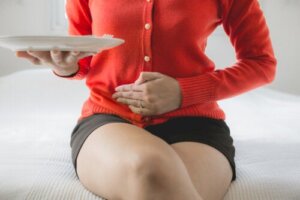Menstruation and Nutrition: How and Why They're Related

Direct and close! This is the relationship between menstruation and nutrition. The menstrual cycle is loaded with hormones that produce variations in tastes and preferences in women. Changes include cravings, increased appetite, and fatty food choices. But how can you help improve this relationship for the benefit of your health? We’ll tell you everything you need to know in the following article.
Learn how menstruation and nutrition are related
Menstruation is a cycle that repeats every month unless the egg is fertilized. The cycle begins at puberty and regularly lasts between 24 and 38 days. During the process, physiological and hormonal changes occur that cause a whirlwind of changes in the body’s emotions, needs, and desires.
The stages that distinguish it are as follows: Menstruation, the follicular phase, ovulation, and the premenstrual (luteal) phase.
1. The menstrual phase
This stage involves the detachment of the inner layer of the uterus. Therefore, it causes pain, tiredness, irritability, and generalized inflammation. This lasts between 5 and 8 days. Estrogen and progesterone levels are low.
Food Magazine, in 2021, explained that the inflammatory process and acute pain should be treated with anti-inflammatory foods such as those containing omega-3. For example, oily fish, nuts, flaxseed, and chia. In addition, as explained in an article published by The University of Edinburg in 2020, this is the time to recover the iron lost with bleeding.
It’s important to accompany foods that are a source of iron with those that have vitamin C, such as guava, peppers, kiwi, and broccoli, among others, and thus facilitate their absorption. At the same time, magnesium will help control estrogens, while potassium should prevail in the diet. Also, anti-inflammatory infusions, such as turmeric and ginger, will help with pain.

2. The follicular phase
This period is counted at the end of the menstrual period and continues until ovulation. Estrogens increase and the ovary prepares to release the egg. Here, there’s an increase in insulin sensitivity, which causes carbohydrates to be used more quickly and efficiently. For this reason, the consumption of whole-grain and fiber-rich carbohydrates is recommended, as refined and free sugars will be absorbed at once.
This condition, together with a lower metabolic expenditure typical of the phase, can favor a gain in body weight. Therefore, it’s important to take care of the diet in terms of carbohydrates and the high consumption of fats.
3. The ovulatory phase
In this phase, the egg is released into the ovary in the middle of the cycle (day 14 or 16) and lasts between 24 and 48 hours. Estrogens reach a peak before ovulation and then decrease. As the body and uterus prepare for fertilization, it’s important to reinforce the diet with foods rich in folic acid and iron. Therefore, a diet rich in leafy vegetables, legumes, nuts, dried fruits, and lean meats should be incorporated.
4. The luteal or premenstrual phase
This is the period between ovulation and the onset of the next menstruation. Progesterone increases as the body prepares for a possible pregnancy and then decreases. For its part, serotonin drops, so there are mood swings and irritability. The Center for Research in Food and Development (CONACYT) of Mexico, in 2021, states that before menstruation, women consume less protein. Likewise, magnesium, calcium, and potassium intakes are deficient, while sodium increases due to higher salt consumption.
At the same time, in the Journal of Nutrition of Food Science in 2015, we read that the hormones insulin and ghrelin may influence taste perception. In addition, a 2023 publication in the International Journal of Environmental Research of Public Health highlights the following: In the luteal phase, women had a greater appetite and consumed more calories in comparison to the control group.
Furthermore, the Revista Brasileira de Ginecologia e Obstetricia, in 2018 comments on the occurrence of cravings with an inclination towards chocolate, sweets, and salt. Scientific literature, in general, also mentions that increased appetite and inclination for caloric foods can lead to weight gain. In addition, some favorable changes in dietary style can reduce premenstrual symptoms.
Read also: The Best Foods to Eat During Menstruation
Adherence to healthy diets and menstruation
The journal Nutrients, in 2020, published a paper on diet and menstruation. It concluded that a healthy diet, similar to the Mediterranean diet, can positively influence cycle length and flow and cause less menstrual pain. Also, it’s explained that eating more fruits such as strawberries reduces menstrual pain, while a higher consumption of legumes increases it.
At the same time, a review on nutrition and dysmenorrhea was also conducted, mentioned in the journal Gynecologic of Obstetric Investigation in 2019. There, it was disseminated that vitamins and minerals from fruits help reduce the inflammatory process and menstrual pain.

Tips for healthy nutrition during menstruation
It’s clear that there’s a close relationship between menstruation and nutrition. Perhaps we can’t say no to the natural process of hormones, but we can say yes to a conscious diet at each stage of the menstrual cycle. That’s why we want to offer you the following tips:
- Maintain a selective fat diet. Eliminate those that are harmful, such as butter, margarine, pastry fats, and other trans fats.
- Reduce sweets in general, such as pastry products, ice cream, desserts, and carbonated and sugary drinks. Fast foods should also be avoided, especially during the premenstrual phase.
- Consume foods that are a source of omega-3 fatty acids, such as sardines, trout, tuna, salmon, albacore, or mackerel. Nuts and seeds, such as flaxseed and chia, also provide them.
- Use olive oil as the culinary fat of choice. Also, it’s advisable to opt for baking, roasting, steaming, or boiling as cooking options
- Consume enough whole fresh fruits. Preference should be given to red fruits.
- Choose proteins of high biological value. Among these, lean meats are recommended. Skimmed dairy products and legumes are recommended, as long as they’re well tolerated.
- Combine meats and legumes with foods that are sources of vitamin C to favor iron absorption.
- Maintain a diet rich in fiber with the incorporation of more vegetable foods.
- Include foods with more tryptophan, such as bananas, nuts, pineapple, and animal proteins.
- Distribute meals in small portions during the day. Between 5 and 6 portions will be fine.
- Reduce the consumption of salt, sugar, caffeine, alcohol, and ultra-processed products.
Menstruation and nutrition: Combine diet with healthy habits
If you keep track of your menstrual cycle, you should ensure that in the luteal phase, you eat a varied, balanced diet, rich in fresh vegetables and low in saturated fats. This will help eliminate unpleasant premenstrual symptoms and promote better health throughout the menstrual process.
It’s best to follow a healthy diet as a lifestyle, combining daily exercise with relaxation activities. Also, don’t forget to drink enough water during the day.
All cited sources were thoroughly reviewed by our team to ensure their quality, reliability, currency, and validity. The bibliography of this article was considered reliable and of academic or scientific accuracy.
- Bajalan, Z., Alimoradi, Z., & Moafi, F. (2019). Nutrition as a Potential Factor of Primary Dysmenorrhea: A Systematic Review of Observational Studies. Gynecologic and obstetric investigation, 84(3), 209–224. https://doi.org/10.1159/000495408
- Barbosa, Diane & Souza, Vanessa & Santos, Larissa & Chiappini, Claudete & Sa, Solange & Azeredo, Vilma. (2015). Changes in Taste and Food Intake during the Menstrual Cycle. Journal Nutrition & food science. 5. 383. 10.4172/2155-9600.1000383.
- Centro de Investigación en Alimentación y Desarrollo. CONACYT ¿Cómo influye la alimentación durante la menstruación? Actualizado 26 de marzo de 2021. Disponible en: https://www.ciad.mx/como-influye-la-alimentacion-durante-la-menstruacion/
- Consumidora. Alimentación y ciclo menstrual: ¿qué comer en cada fase? Revista Alimentaria. Actualizada: 02/02/2021. Disponible en: https://www.revistaalimentaria.es/consumidora/alimentacion-mujer/alimentacion-ciclo-menstrual-comer
- Onieva-Zafra, M. D., Fernández-Martínez, E., Abreu-Sánchez, A., Iglesias-López, M. T., García-Padilla, F. M., Pedregal-González, M., & Parra-Fernández, M. L. (2020). Relationship between Diet, Menstrual Pain and other Menstrual Characteristics among Spanish Students. Nutrients, 12(6), 1759. https://doi.org/10.3390/nu12061759
- Quaglia, C., Nettore, I. C., Palatucci, G., Franchini, F., Ungaro, P., Colao, A., & Macchia, P. E. (2023). Association between Dietary Habits and Severity of Symptoms in Premenstrual Syndrome. International journal of environmental research and public health, 20(3), 1717. https://doi.org/10.3390/ijerph20031717
- Souza, L. B., Martins, K. A., Cordeiro, M. M., Rodrigues, Y. S., Rafacho, B. P. M., & Bomfim, R. A. (2018). Do Food Intake and Food Cravings Change during the Menstrual Cycle of Young Women?. A ingestão de alimentos e os desejos por comida mudam durante o ciclo menstrual das mulheres jovens?. Revista brasileira de ginecologia e obstetricia : revista da Federacao Brasileira das Sociedades de Ginecologia e Obstetricia, 40(11), 686–692. https://doi.org/10.1055/s-0038-1675831
- The University of Edinburg. Menstruación y Nutrición. Consultado el 22 de abril de 2023. Disponible en: https://www.ed.ac.uk/centre-reproductive-health/hope/menstruation-and-nutrition.
- Tosti, V., Bertozzi, B., & Fontana, L. (2018). Health Benefits of the Mediterranean Diet: Metabolic and Molecular Mechanisms. The journals of gerontology. Series A, Biological sciences and medical sciences, 73(3), 318–326. https://doi.org/10.1093/gerona/glx227
This text is provided for informational purposes only and does not replace consultation with a professional. If in doubt, consult your specialist.
